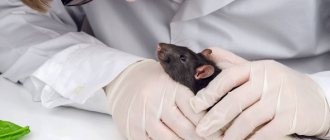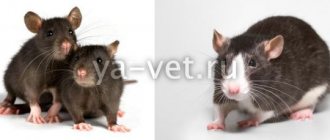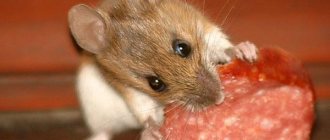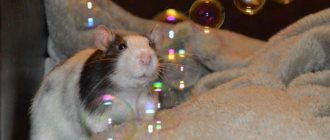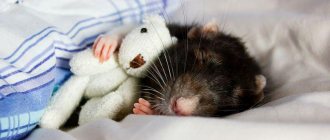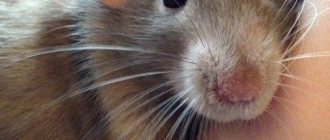- home
- Rats
- First aid for rats
| GENERAL SERVICES | Price |
| Calling an emergency veterinarian | from 1500 rub. |
| Calling an emergency veterinarian at night | from 2000 rub. |
| Consultation | from 500 rub. |
In favorable conditions, decorative rats live less than 5 years. During this time, they suffer many diseases, fractures, colds, etc. Timely help can save the life of a rodent.
The rat’s tail has darkened or is peeling, what should I do?
Rats are considered one of the cleanest animals. But their tail is a part of their body that can sometimes get a little dirty. You can tell if a tail is very dirty by looking at the color: if it is darker than usual, it may be time to wash it. If the tail is very dirty, it can also peel off.
Cleaning a rat's tail is quite simple. Simply use a soap and water solution, dip a piece of cloth in it, and wipe the tail. If the tail is very dirty, you can also soak it in a warm solution of soap and water.
When cleaning a rat's tail, be careful. It is better not to suddenly grab animals by the tail. This can frighten them and even traumatize them.
What to do if your rat is panting, choking, or grunting
Treatment of cardiovascular or respiratory pathology should be prescribed by a veterinarian, but if breathing problems occur and uncharacteristic sounds appear when inhaling and exhaling, the owner can provide first aid to the animal.
Heart attack
If a rat is breathing heavily, choking, wheezing and at the same time there is a blueness of the tip of the tail and fingers, paleness of the tail and ears, or convulsions and chaotic movements of the limbs - this is a heart attack!
It is urgent to drop one drop of Cordiamine or 2-3 Corvalol on your pet’s tongue, let him smell any aromatic oil and immediately take the animal to a specialist or call a doctor at home.
Pneumonia
If the rat breathes frequently and heavily from the sides, sneezes and coughs, wheezes and whistles when breathing, hunches its back, refuses to eat, and red, dried crusts are found in the eyes and nose, it may be pneumonia.
The animal must be provided with access to air; in warm weather, the animal can be carried outside in the shade or on the balcony. It is advisable to examine the rodent’s oral cavity and remove mucus, foam and food debris from the mouth if found. You can pour 10% camphor oil into a saucer or onto a cotton pad and let the rat smell it. To relieve asthmatic syndrome, the animal needs an urgent injection of aminophylline, dexamethasone and furosemide in one syringe or an oxygen chamber, but such actions must be carried out by a specialist with a veterinary or medical education.
A rat fell from a height, what should I do?
If a rat has fallen from a height, you should first calm the pet down. Do not touch the animal for several minutes, let the rat come to its senses. However, do not lose sight of the rodent. If the pet has not recovered from shock after a long time, inject 0.1 ml of Prednisolone subcutaneously (into the withers) and pour 0.5 ml of Nurofen into the oral cavity to eliminate any discomfort.
Then monitor the rat's behavior for 48 hours. If the animal behaves normally and can move around calmly, then everything is fine with the rodent. However, if your pet begins to limp and lick its tail or limbs, seek help from a veterinary clinic.
Respiratory diseases in rats and mice
One of the most common reasons for visiting a veterinary clinic with rats and mice is respiratory diseases.
In eighty percent of cases, there are complaints of heavy breathing, wheezing, sniffling, and discharge from the nasal passages. In addition, respiratory pathologies are detected in half of the cases of visits to the clinic for other reasons.
There are a number of infections of bacterial, viral or fungal etiology that can cause respiratory tract diseases in mouse-like rodents.
Mycoplasmosis in rodents
The main pathogen for rats and mice is Mycoplasma pulmonis, which causes chronic respiratory syndrome, many of the symptoms of which do not appear suddenly, but increase with age of the animal.
This happens as follows. You buy a small pet, he is cheerful and active, has an excellent appetite, gains weight well and does not show any signs of illness. Then your pet grows and sometimes you begin to notice that he sniffles in his sleep, during an intense walk or while eating. Sometimes you hear sneezing, after which the animal washes itself more thoroughly, and you can observe a “rusty coating” on the fur in the muzzle area. At the same time, appetite and activity do not change. After some more time, your pet becomes less active, shortness of breath is noted - the sides are heaving heavily, and there is constantly dried discharge around the eyes and nose. Weight loss is observed. And after some time, the animal begins to open its mouth when breathing, the mucous membranes acquire a pale or bluish tint, the pet rapidly loses weight, and moves little. Such changes can occur over a period of several weeks to several months. And the sooner you seek help from a veterinary clinic, the greater the chance that your pet will live a long and comfortable life.
Signs of mycoplasmosis
So, the clinical signs of mycoplasmosis may vary depending on the location of the process and the stage of the disease.
If the upper respiratory tract is affected, sneezing, snoring, discharge from the nose and eyes may be present; the rat often rubs its nose with its paws, the fur around the eyes and nose is stained with porphyrin. As the disease progresses, the infection spreads to the lower respiratory tract, where it can cause bronchitis and bronchopneumonia. Auscultation can detect “rumbling” wet sounds when breathing. The corresponding symptoms are: cough, shortness of breath, weight loss, apathy, change in color of the mucous membranes.
In addition to respiratory symptoms, mycoplasmosis in rats and mice is often accompanied by the appearance of scratching on the skin, and in females the reproductive tract is also affected (bleeding or purulent discharge from the genitals). Mycoplasmosis also causes otitis media, signs of which may include discharge from the external auditory canal, tilting of the head, loss of orientation in space - the animal “walks in circles.”
Mycoplasmosis infection
Infection with mycoplasmosis can occur in several ways: from a female to her offspring, through sexual contact, or by airborne droplets. Infection is facilitated by weakened immunity, crowded housing, and poor ventilation of the habitat. According to existing data, Mycoplasma pulmonis is not a pathogen for humans and other non-mouse-like rodents. However, it is very common and contagious among mice and rats.
Treatment of mycoplasmosis in rats and mice
As mentioned above, mycoplasmosis in rats occurs in a chronic form, and unfortunately, there are no drugs that can completely cure this disease. As a rule, therapeutic treatment is aimed at suppressing the infectious process to improve the quality of life and its duration. From the moment the first signs of mycoplasmosis appear, the animal can live for many months; a properly selected course of treatment plays a very important role in this.
To suppress symptoms, only certain antibiotics are successfully used, and in especially severe cases, their combinations. One of the features of mycoplasmas is the absence of a cell wall; this determines their resistance (resistance) to certain groups of antibiotics. Therefore, not every drug in the medicine cabinet will help overcome the disease. The choice of antibiotic, dosage and duration of the course are selected based on the age of the animal, stage of the disease, the presence of concomitant pathologies and a number of other reasons. Often, in order to prescribe effective treatment, in addition to examination and auscultation, a number of additional studies are required, which include radiography and laboratory diagnostics.
In the final stages of the disease, if indicated, in addition to antibiotics, the use of glucocorticoids, diuretics and bronchodilators may be required.
In cases of severe shortness of breath, an oxygen chamber is indicated for the animal until the condition stabilizes, so it is useful for owners of such animals to always have an oxygen canister on hand, which is sold in pharmacies.
Oxygen chamber for rodents at home: an oxygen tank is connected to a plastic box or carrier using a rubber tube (the side holes in the carrier can be sealed with tape to ensure a higher concentration of oxygen):
To prevent disturbances in the gastrointestinal tract due to long-term antibiotic therapy, in some cases I recommend drugs that normalize the microflora. In addition, it is possible to correct the feeding diet, because Animals require more energy to maintain the vitality of the body and fight infection, so easily digestible and nutritious foods should be included in the diet.
Sometimes having a humidifier and regular irrigation of the mucous membranes of the nasal passages, for example with AquaMaris spray, also helps to make breathing easier.
Animal owners must remember that under no circumstances should they interrupt the prescribed course of treatment at the first signs of relief, and also change the dosage of the prescribed medications! You should not independently select medications for treatment, since an incorrectly selected drug or its dosage will not only not help your pet feel better, but can also lead to retardation in growth and development in young animals, abortion in pregnant females, and death in older animals .Strict adherence to the specialist’s recommendations will help prolong your pet’s life and make it as comfortable as possible.
When purchasing new animals and intending to place them with other pets, it is necessary to observe quarantine for at least 3-4 weeks.
Mycoplasmosis makes the body of rats and mice more susceptible to secondary bacterial infections (causative agents Streptococcus pneumoniae, Corynebacterium kutscheri, Pasteurella pneumotropica, Pneumocystis carinii, etc.). They can cause both independent diseases (for example, pneumonia, lung abscesses) and occur in combination with mycoplasmosis, which greatly complicates the animal’s condition. Unlike mycoplasmosis, which is chronic, these infections most often occur acutely, and if you do not contact a specialist in a timely manner, the prognosis is extremely unfavorable.
Lung abscess in a rat
Tumors in rodents
Besides infectious diseases, there are also a number of other reasons why your rat or mouse may be sneezing, coughing, or having difficulty breathing.
Rats and mice are prone to developing tumors. Sometimes the cause of difficulty breathing can be a tumor in the lungs or metastases. Unfortunately, it is impossible to prevent this process, but if it is detected in a timely manner (the most effective and accessible method is radiography), the animal can breathe easier and create more comfortable conditions for life in general. There are several regimens that are used for cancer, they include the use of drugs that inhibit the growth of cancer cells, drugs that make breathing easier, as well as oxygen therapy, a special diet high in nutrients, etc.
Radiography is one of the available and effective methods for making a diagnosis:
Lung tumors in rats
Heart diseases
Heart disease can also cause heavy breathing. For diagnosis, auscultation (listening) of the heart, radiography, and ultrasound of the chest are used. Under the supervision of a specialist, most heart pathologies can be controlled through therapeutic treatment, and the animal may not show signs of shortness of breath for a long time and feel well.
Pulmonary edema in a rat with heart failure:
Prevention of diseases in rodents
Speaking about respiratory diseases, we should also mention such a provoking factor as the environment. The correct choice of bedding plays a vital role here.
It is quite logical that the litter needs to be changed in a timely manner - this is the prevention of many diseases, not only respiratory ones. If the animal is kept in a terrarium or a dune-type cage, the filler should be changed more often than in a lattice cage, due to poorer air ventilation.
Now about what kind of filler should be used in mice or rats.
In almost all cases where wood granular filler is used as bedding, sooner or later the rodents will develop respiratory problems. This is not to say that this filler is so bad, it just should be used for other animals. For example, the cats for whom it is intended do not sit in their litter box all day long, but come to it for a couple of minutes a day. Rodents spend almost all their time on the litter; it gets wet from urine, then dries, and after running on it, the animal inhales tiny particles that cause irritation of the mucous membranes. Then a response appears - the animal sneezes. Subsequently, this leads to severe inflammation of the upper respiratory tract, rhinitis, and it becomes difficult for the animal to breathe.
Currently, pet stores offer a wide range of fillers for keeping mouse-like rodents. Corn filler has proven itself best, as it perfectly absorbs moisture, absorbs odors, does not generate dust and does not require very frequent replacement. An alternative is cellulose rodent litter. Don't try to replace it with toilet paper or napkins - they are not the same thing!
Dry air in the house can also provoke sneezing and nasal discharge. First of all, this applies to the autumn-winter period, when heating devices are turned on in the apartment, windows are rarely opened, the air becomes dry and contributes to irritation of the mucous membranes of the respiratory tract. Ventilate the premises in a timely manner and control air humidity. The air humidity in the room where rodents are kept should not be lower than 40%.
There should be no strong odors in rooms where rodents are kept. Do not use air fresheners, scented candles, or other items with irritating odors near cages.
© 2012 Tishkina Svetlana Vladimirovna
Vkontakte
My pet has blood in his urine, what should I do?
Seeing blood in a rat's urine is definitely scary. Blood means something is going wrong somewhere in the urinary tract, with many possible causes. Hematuria is not a condition that can go unnoticed by the owner; it needs to be treated immediately. Each potential cause of this dreaded symptom can potentially lead to death if left untreated. Not every condition will cause a rat to meet its untimely death, but it is quite possible if the rat's health is neglected.
The main reasons for the appearance of blood in a pet’s urine:
- Bladder infection
A urinary tract infection can cause blood when you urinate. Severe infections can cause severe damage to the urinary tract, resulting in bleeding. Bleeding indicates a sufficiently advanced infection that requires immediate treatment to save the rat's life.
- Kidney disease or failure
If the kidneys become diseased or begin to fail, they too can cause blood to form in the rat's waste. Severe kidney inflammation may even result in excessive or very little urine output, depending on the condition of the kidneys. Most owners may not know what is normal for their rat, so it is always a good idea to monitor your rat's litter box habits when you suspect the animal may be sick or not feeling well.
- Stones in the kidneys
Just like humans, rats can get kidney stones. As you might have guessed, it's incredibly painful for them too. As kidney stones travel from the kidney to the bladder and out the urethra, they can cause some damage. Rats with kidney stones need to be given antibiotics to prevent the damage from leading to infection. Poor diet may also be a major cause.
- Worms in the bladder
Threadworms are highly invasive parasites that can destroy a rat's bladder and ultimately kill it. Antiparasitic drugs will be needed here. If the worms are not killed, the rat's health will only deteriorate. In addition, any other rats that share the cage with the infected rat will need to be treated. It's almost a promise that other rats are also infected to some degree.
- Tumors and cancers
Unfortunately, rats can develop cancer of the urinary tract. Most often it is kidney cancer or bladder cancer. Other neoplasms and tumors can also affect the urinary system, especially in later stages. Any tumor in a body cavity can grow large enough to shut down the kidneys or the entire urinary system. In this case, the rat should be euthanized when the quality of life deteriorates significantly.
The best way to get rid of blood is to eliminate the cause of the bleeding. A rat will not urinate blood for no reason. Instead, there is something that is causing damage to the urinary tract. Any bacterial infection will require rat-safe antibiotics.
In case of inflammation, steroids and anti-inflammatory drugs may be prescribed. This will reduce swelling, preventing the organ or tissue from causing more harm to itself, and as a result, reduce pain. Bacterial infections will require one of a variety of antibiotics, depending on what pathogen is causing the infection. When it comes to pain, such as kidney stones or tumors, painkillers such as Metacam can significantly improve the quality of life of a sick rat.
The rat choked, what should I do?
Choking is a painful act that occurs mainly due to negligence. This is a life-threatening situation because in this situation the airway is blocked. This condition is usually caused by food particles. Food, instead of getting into the proper path it should take, will move towards the respiratory tract, which causes suffocation. If you don't act quickly, it can be fatal to the rat.
To prevent the possibility of food getting stuck in the animal’s throat, it is necessary to develop a safe diet for the rodent. If a rat chews its food incorrectly, choking may occur. Thus, the diet should only include food that the pet can easily chew and swallow very easily.
If your rat is choking, you can prevent choking using the following methods:
- Turning over the animal
This is the easiest way to immediately remove the choking hazard. The owner needs to turn the rodent's body over and bend it slightly. In such a way that you can press his chest with your palm. It is necessary to press on the chest with very careful movements. Chest compression helps the pet clear the object from the airway so it can be saved.
- Use a cotton swab
Using a cotton swab, you can remove the object from the rat's respiratory tract. In this method, a stick is inserted into the throat through the mouth. Such a stick can penetrate deep into the throat and pull out an object.
- Operation
This method is very critical and risky. Specialists make an incision in the neck to remove the foreign object from the airway. If the previous two methods did not work, then this is the last method that can save your pet's life. The operation can only be successful if it is performed on time.
How to tell if an animal is choking
By its very behavior the animal will make it clear that it has choked. It will wilt, its activity will be at zero, it will lie motionless, hanging its head down, or crawl away to a secluded place. The rat's body may shake slightly, as if it is having convulsions. The animal will make movements with its neck, stretching and contracting it, as if it wants to make a swallowing movement. Saliva may flow profusely from the mouth and foamy mucus may appear. These symptoms do not necessarily appear all together, so if any of them are present, the rat should be examined.
The rat began to hiccup frequently, what should I do?
Rat hiccups are not exactly like human hiccups. If your rat rarely hiccups, then this is normal. But in any other case, it could be a sign of respiratory problems and lead to something serious.
Hiccups are an involuntary spasm of the diaphragm muscle. As a natural reflex, the vocal cord closes, resulting in the characteristic human sound of hiccups. But when it comes to rats, the sound cannot be heard. But you can notice rhythmic twitching of the body.
There are several ways to find out if your rat's hiccups can be simply ignored or if you need to take serious action. The first way is to check whether the animal's hiccups have a sound. Normal hiccups in rats are silent. If hiccups are accompanied by a squeaking sound, this may be a sign of a respiratory problem.
Another way to tell if a rat's hiccups can be ignored is to see if they continue to move between hiccups. If they do this, it is a sign that the hiccups are a passing phenomenon. If instead they stay in one place (usually in a corner) while they do this, then this is a sign of something more serious. In this case, you should consider taking your rat to the vet for a full examination.
Under normal conditions, rats hiccup as a result of excitement. This can happen while playing or while eating. Although some rats hiccup when they are upset or angry, hiccups are mostly associated with positive feelings of arousal.
But in more serious cases, rat hiccups may be a symptom of active Myco pulmonis, a certain bacteria that pet rats are infected with from birth. Some researchers even believe that any hiccups in rats are due to Myco pulmonis infections.
Most veterinarians will recommend some kind of antibiotic for this condition, such as Baytril (2 mg/tablet for rats) and Doxycycline for 2-6 weeks. Most rats recover by this time and the hiccups go away.
All rats are born with a predisposition to Myco infection and will show symptoms (such as hiccups) every now and then. Some rats show symptoms more often than others. If you follow all the recommendations of experts, your furry friend will recover in no time.
Posts 1 page 30 of 30
Share12010-01-04 22:23:01
Good evening! My rat is 2 years old, for the last two weeks she has had a lot of discharge from her nose (similar to blood), is breathing heavily, and is sneezing. He doesn’t eat anything (or very little from his hands, if forced), and doesn’t drink water from the drinking bowl (we drink water from a syringe). I have lost a lot of weight, about half, if not more. Weakness is very noticeable, although he walks more or less, he generally drags his hind legs! Doesn't respond when I call, this has never happened before!
Today we went to the clinic, the doctor said it was heart failure! But this begs the question: is it possible to determine (visually) whether this is so? After all, the doctor didn’t even take Sanya in her hands. I just showed her nose, said that she doesn’t eat anything, doesn’t drink, she’s lost so much weight! You can see from the rat that she’s breathing very hard! Actually, that’s all they told me, they added that you can try to treat, pierce, for at least 5 days, if it gets better, then continue, no, put me to sleep!
What do you say about this? ________________________________ thank you in advance!
Share22010-01-04 22:43:57
- Author: Pyatihatochka
- Participant
- From: Ukraine, Kharkov
- Registered: 2009-08-14
- Invitations: 0
- Posts: 8175
- Female gender
- Age: 40 [1980-11-14]
- Spent on the forum: 1 month 28 days
- Last visit: 2013-10-15 19:28:31
Are there any sounds when breathing? Are your paws turning blue? Are your teeth of normal length? Are there still doctors who can LISTEN to the HEART for arrhythmia and the like, as well as the lungs and airways for wheezing?
Please don't be surprised - I edited the title of the topic. Topic titled “Help. “does little to show the essence of the problem and there shouldn’t be 100 such topics on the forum. We need specifics.
How to inject a rat yourself?
To safely administer the injection, the animal must be restrained. This will require two people. Rats are generally docile animals, especially if they are handled regularly using appropriate methods. Rat bites are rare and usually only happen when the animal is stressed or in pain. To hold the rat, one person should gently grab it by the shoulders.
The thumb can then be placed under the rat's lower jaw to prevent biting, and the rat's hind legs can be supported with the other hand. The restriction should be tight, but not too tight, as this will interfere with the animal's breathing.
To administer the medicine subcutaneously to an animal, you need to wrap two fingers around the back of the rat's neck and insert a needle into this area, slowly injecting the solution. With the intramuscular method, a syringe is inserted into the fleshiest part of the thigh.

